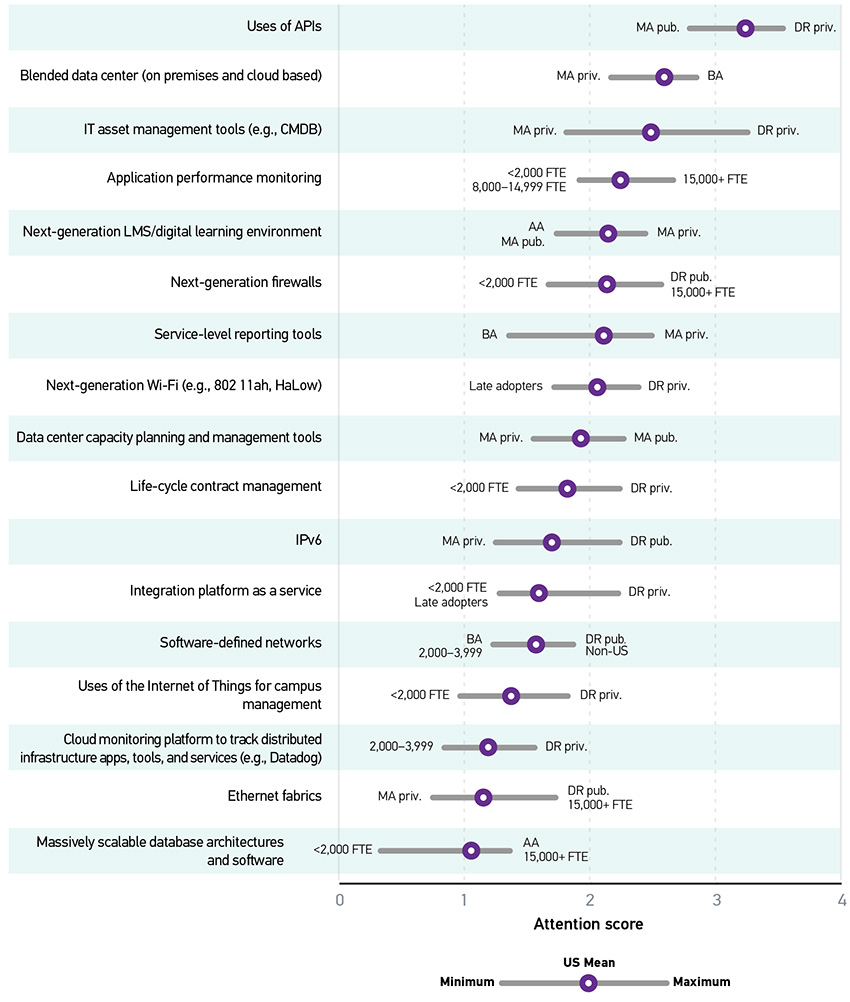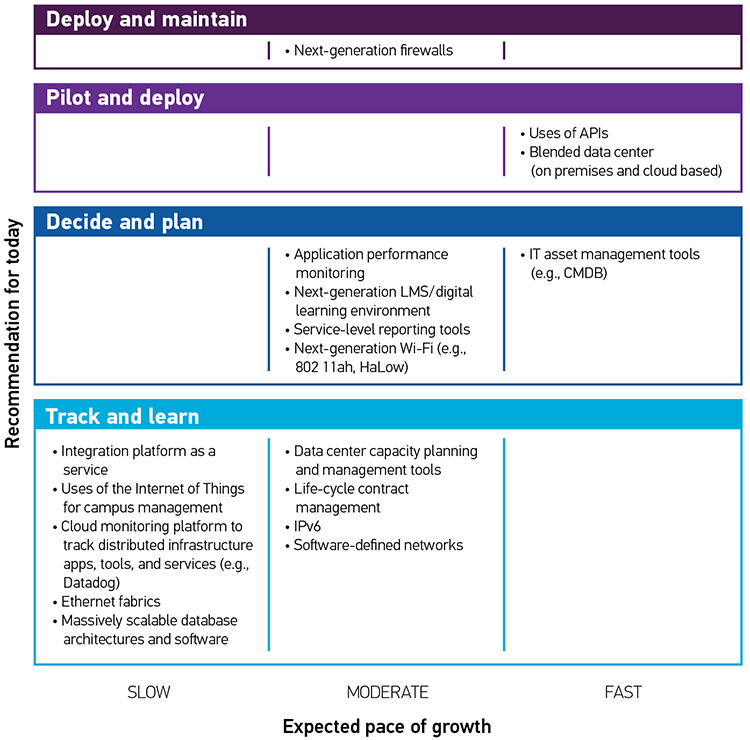Infrastructure and Operations
Heraclitus of Ephesus is widely credited with the sentiment that the only constant is change. For the infrastructure and operations domain, a slight revision to the proviso is necessary: the only constant is rapid change. The higher education technology landscape continues to evolve. This evolution is recognized in the 2018 EDUCAUSE Top 10 IT Issues, where the importance of an institution-wide IT strategy (issue #3) and digital integrations (issue #8) make clear that an institution's IT strategy—and the IT infrastructure and operations that support that strategy—must be designed to support the institution and help it achieve its mission. IT strategy cannot succeed if IT infrastructure and operations cannot support rapid forward progress during a period of great change. The Internet of Things (IoT), increasing use of the cloud, and high demand to support multiple platforms, devices, and levels of connectivity mean that colleges and universities must deliver integrated technologies and services quickly in an increasingly complex environment.
This section covers the 18 trends and 17 technologies included in the infrastructure and operations domain. The two trends significantly influencing institutional infrastructure and operations posture—the contributions of IT to institutional operational excellence, and the increasing complexity of technology, architecture, and data—hint at this domain's strategic importance during a time of great transition. The only technological constant is rapid change, and a digital transformation in higher education must take place.
Trends
Included in this domain:
- Agile approaches to change
- Bimodal IT
- Changing enterprise system architectures, integrations, and workflows
- Climate change
- Contributions of IT to institutional operational excellence
- Cross-institutional partnerships and consortia
- DevOps movement
- Incorporating open standards into enterprise IT architecture
- Incorporating risk-management approaches into IT strategy and service delivery
- Increasing complexity of technology, architecture, and data
- Institution-wide data management and integrations
- Internet of Things
- Managing mobility (of people, data, institutional resources)
- Service management (ITSM, ITIL)
- Shared services
- Strategic relationships with vendors
- User-centered design
- Vendor relationships that bypass IT
Understand how the most influential trends are affecting your institution.
Two trends are influential at 61% or more of colleges and universities:
- Contributions of IT to institutional operational excellence
- Increasing complexity of technology, architecture, and data
Review the trends that are taking hold and address them at your institution.
Seven trends are influential at 41–60% of institutions (listed below from highest to lowest level of influence):
- Institution-wide data management and integrations
- Changing enterprise system architectures, integrations, and workflows
- Strategic relationships with vendors
- Incorporating risk-management approaches into IT strategy and service delivery
- Service management (ITSM, ITIL)
- Managing mobility (of people, data, institutional resources)
- Shared services
Understand these trends, and consider their possible role at your institution.
The influence of five trends is limited to 21–40% of institutions. Higher education is monitoring these trends with respect to emerging IT strategy and the deployment of infrastructure and operations strategic technologies (listed below from highest to lowest level of influence):
- Cross-institutional partnerships and consortia
- User-centered design
- Vendor relationships that bypass IT
- Agile approaches to change
- Incorporating open standards into enterprise IT architecture
The remaining four trends were of limited impact in our research:
- Internet of Things
- Bimodal IT
- DevOps movement
- Climate change
Technologies
Included in this domain:
- Application performance monitoring
- Blended data center (on premises and cloud based)
- Cloud monitoring platform to track distributed infrastructure apps, tools, and services (e.g., Datadog)
- Data center capacity planning and management tools
- Ethernet fabrics
- Integration platform as a service
- IPv6
- IT asset management tools (e.g., CMDB)
- Life-cycle contract management
- Massively scalable database architectures and software
- Next-generation firewalls
- Next-generation LMS/digital learning environment
- Next-generation Wi-Fi (e.g., 802.11ah, HaLow)
- Service-level reporting tools
- Software-defined networks
- Uses of APIs
- Uses of the Internet of Things for campus management
Complete initial deployment and maintain these technologies.
Our research shows that half of institutions are planning to deploy and maintain one infrastructure and operations strategic technology:
- Next-generation firewalls
Pilot and start deploying these technologies.
At this time, a majority of institutions are planning to pilot and deploy these two infrastructure and operations strategic technologies (listed below from highest to lowest attention):
- Uses of APIs
- Blended data center (on premises and cloud based)
Decide when these technologies fit your strategy, and start planning.
About one-half of institutions are watching these five infrastructure and operations strategic technologies carefully, deciding and planning for potential future deployment (listed below from highest to lowest attention):
- IT asset management tools (e.g., CMDB)
- Application performance monitoring
- Next-generation LMS/digital learning environment
- Service-level reporting tools
- Next-generation Wi-Fi (e.g., 802.11ah, HaLow)
Learn about and track these technologies.
About one-half to three-quarters of institutions are tracking and learning about the following nine infrastructure and operations strategic technologies (listed below from highest to lowest attention):
- Data center capacity planning and management tools
- Life-cycle contract management
- IPv6
- Integration platform as a service
- Software-defined networks
- Uses of the Internet of Things for campus management
- Cloud monitoring platform to track distributed infrastructure apps, tools, and services (e.g., Datadog)
- Ethernet fabrics
- Massively scalable database architectures and software
Peer Institution Approach to Strategic Technologies
Understanding what peer institutions (both current and aspirational) are doing can help you gauge whether your institution's current approach is on track or might warrant reconsideration. Some technologies are more relevant for some types of institutions than others. We looked at broad demographic categories, including Carnegie class, institutional size, and approach to technology adoption and found differences in attention score based on those factors. (See the methodology section for explanation of our attention score calculation.) In figure 5, the US mean is the average attention score for an item from all US respondents. The minimums and maximums are the lowest and highest average attention scores among all groups within the categories of Carnegie class, institution size, and timing of technology adoption, with labels indicating which group or groups returned that score. In the event of a tie, all tied groups are represented.

Preparing for the Future
Understanding the technologies that are most relevant for your institution and how fast a certain strategic technology may be growing is critical to institutional IT strategy. We estimated the pace of growth based on the percentage of institutions we predict will implement each technology over the next five years (by 2023). Figure 6 positions each technology in one of 12 cells based on institutional intentions (the "recommendation for today") and the expected pace of growth of that technology. Reflecting what was noted above, the figure shows that institutions continue to track and learn about a number of technologies, with only a couple of technologies on the fast track to reaching the pilot, deploy, and maintain stages.
